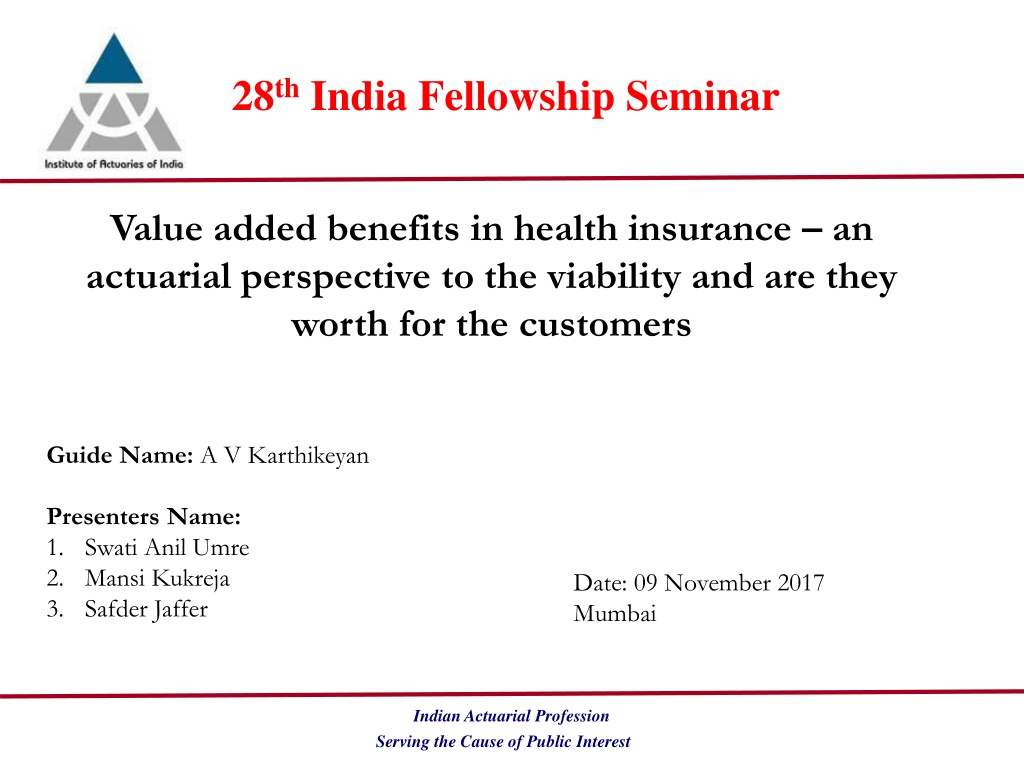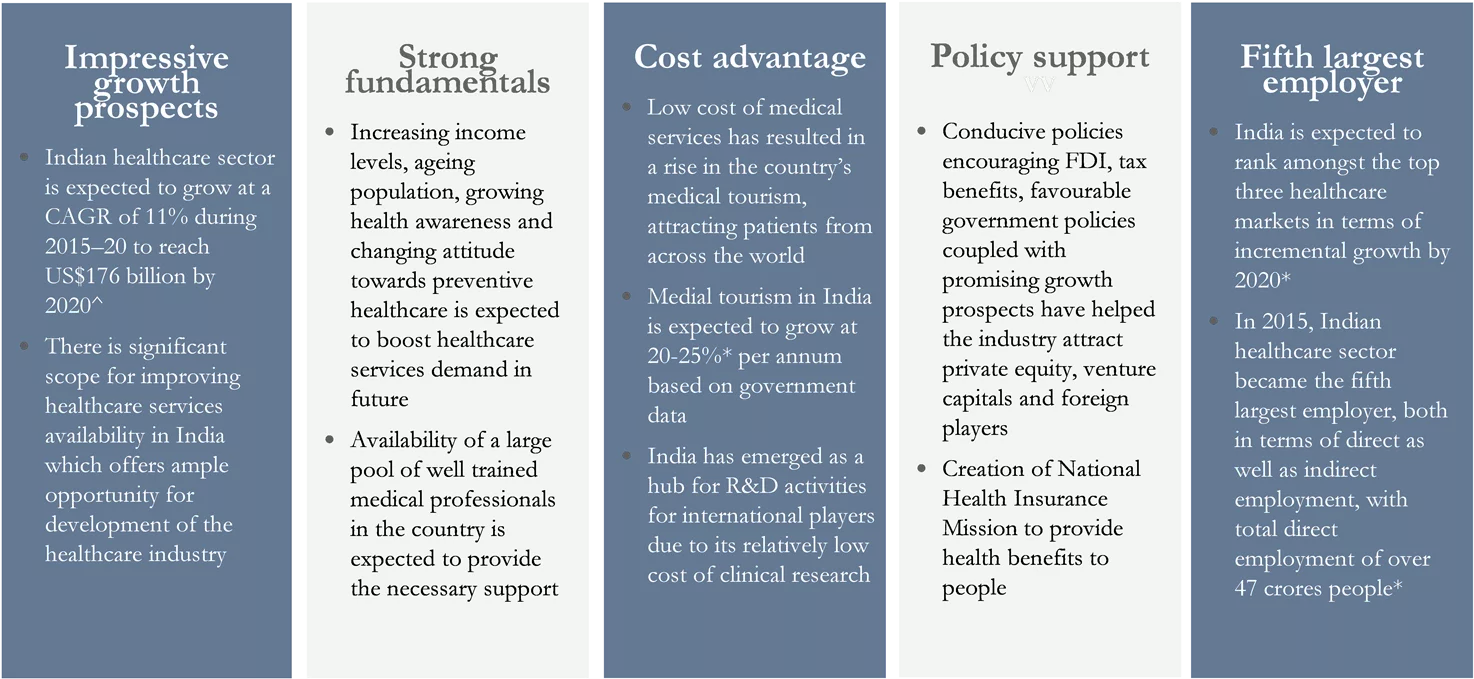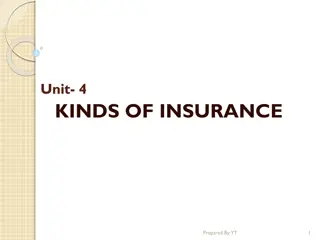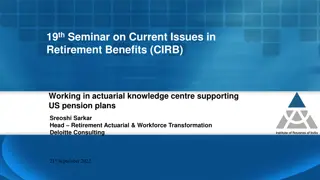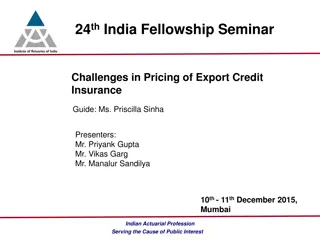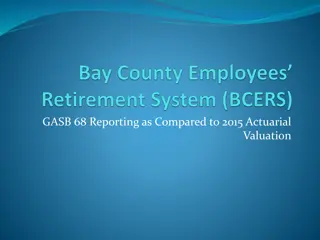Actuarial Perspective on Value Added Benefits in Indian Health Insurance
Explore the viability and customer benefits of value added benefits in health insurance from an actuarial perspective at the 28th India Fellowship Seminar. The Indian healthcare industry's growth prospects, policy support, and the role of health insurance are discussed, highlighting the opportunities and challenges in pricing approaches. With a strong focus on public interest, the seminar delves into the evolving landscape of healthcare services in India.
Download Presentation

Please find below an Image/Link to download the presentation.
The content on the website is provided AS IS for your information and personal use only. It may not be sold, licensed, or shared on other websites without obtaining consent from the author. Download presentation by click this link. If you encounter any issues during the download, it is possible that the publisher has removed the file from their server.
E N D
Presentation Transcript
28th India Fellowship Seminar Value added benefits in health insurance an actuarial perspective to the viability and are they worth for the customers Guide Name: A V Karthikeyan Presenters Name: 1. Swati Anil Umre 2. Mansi Kukreja 3. Safder Jaffer Date: 09 November 2017 Mumbai Indian Actuarial Profession Serving the Cause of Public Interest
Agenda Introduction to the Indian Healthcare Industry Defining Value Added Benefits Benefits and Limitations: For the Customer Benefits and Limitations: For the Insurer Pricing Approaches: Risks & Challenges Associated With Pricing Conclusions 2 www.actuariesindia.org
Health care is one of the most promising sectors of the Indian economy Salient features of Indian healthcare industry Policy support vv Strong fundamentals Cost advantage Fifth largest employer Impressive growth prospects Low cost of medical services has resulted in a rise in the country s medical tourism, attracting patients from across the world Conducive policies encouraging FDI, tax benefits, favourable government policies coupled with promising growth prospects have helped the industry attract private equity, venture capitals and foreign players India is expected to rank amongst the top three healthcare markets in terms of incremental growth by 2020* Increasing income levels, ageing population, growing health awareness and changing attitude towards preventive healthcare is expected to boost healthcare services demand in future Indian healthcare sector is expected to grow at a CAGR of 11% during 2015 20 to reach US$176 billion by 2020^ Medial tourism in India is expected to grow at 20-25%* per annum based on government data In 2015, Indian healthcare sector became the fifth largest employer, both in terms of direct as well as indirect employment, with total direct employment of over 47 crores people* There is significant scope for improving healthcare services availability in India which offers ample opportunity for development of the healthcare industry 3 4 5 www.actuariesindia.org 1 2 Availability of a large pool of well trained medical professionals in the country is expected to provide the necessary support India has emerged as a hub for R&D activities for international players due to its relatively low cost of clinical research Creation of National Health Insurance Mission to provide health benefits to people Source: * IBEF ^ World Health Organization (WHO), BMI 3
Overview of the Indian health insurance market IRDAI licensed health insurance Self funded schemes Group Retail Group health insurance cover (either employer- employee or non employer- employee (like holders of the same credit card, etc.) Many governmental and public sector institutions, as well as some private corporates (e.g. Unilever, P&G) have self-funded health insurance schemes Certain government schemes are self-funded as well 4 public sector, 18 private sector general insurers that can sell health insurance 6 stand-alone health insurers with Aditya Birla as a new entrant in 2016 Few life insurance players* provide health insurance such as LIC Individual or family floater Tax benefit under section 80D Government Sponsored Segments Players RSBY (Rashtiya Swasthiya Bima Yojana) Other State sponsored insurance schemes Indian Health Insurance sector Personal Accident* Limited Indemnity Third party Agency Products Channels Loss of life due to accident Permanent temporary disability Brokers Bancassurance Corporate agents Web aggregators Reimbursement against the costs of medical expenses Direct payment to provider as an option, known as cashless Traditional agents Variable agency model and Online/Digital Critical Illness* Overseas Travel* Direct / Telesales Lump sum payment on diagnosis of one of the specific life threatening illness Website sales Tablet / mobile app Aggregators E-commerce tie ups Direct sales staff Call-centre Overseas Mediclaim insurance Loss of flight & luggage Add on coverages (e.g. Dental) * Not a significant portfolio Category accounts for major share of the segment www.actuariesindia.org
Complementing the growth in healthcare industry, health insurance sector has also experienced an impressive CAGR of ~17% between FY 12-16 Health insurance GWP In INR Bn. 485 244 201 175 155 131 - FY 12 FY 13 FY 14 FY 15 FY 16 FY 20 (P) Key growth drivers for health insurance Regulatory reforms and tax incentives Increasing Healthcare costs Increased Awareness High out of pocket expenditure Technology New technologies disrupting health insurance Insurers launching mobile apps & internet based services Recognition of Health insurance as a standalone class; allowing more opportunities through open architecture Increase in tax benefits in 80D from 15K to 25K Healthcare expenditures continue to rise as the government modernizes India s healthcare system Increasing awareness of health insurance and growing perception of insurance needs among people, evidenced by ~21% growth in the retail health insurance 62% per cent of the total health care expenditure in the country was borne by households out of their pockets in 2014 3 4 5 1 2 www.actuariesindia.org Source: WHO Study; IRDA Annual reports
Health insurance products falls under two main categories Limited indemnity Fixed benefit 10% 90% In-patient cover Hospital cash Covers hospital treatment that requires a stay of one or more nights Pays an assured amount for days spent in hospital irrespective of type and amount of the bill 01 06 Surgical cash Out-patient (OPD) Pays for any in-patient or day surgery, depending on the severity of the operation and typical recovery period Health Insurance Products Covers hospital treatment that doesn t requires an overnight stay 05 02 Health + Savings Critical illness Health insurance that rewards you with saving points on adoption of healthy practices Provides lump-sum benefit on diagnosis of Critical Illness / Major Medical Illnesses and procedures 04 03 In India, currently 90% of health insurance products are indemnity but fixed benefit products have started gaining traction in recent times www.actuariesindia.org
Value Added Benefits in Health Insurance Maternity benefit Dental cover Restoration Wellness programs Cover for all the expenses involved in the delivery of a child and/or expenses related to medically necessary and lawful termination of pregnancy. 1 Reimbursement of medical expenses incurred in connection with treatment of any injury or illness to natural tooth/teeth. Reinstatement of 100% of Sum Insured (once in a policy year) if the claim is not related to the illness for which a claim has been made earlier in the year. 3 To promote, incentivise and reward the policyholder for his healthy behaviour through various wellness services. 4 www.actuariesindia.org 2 7
Are Value Added Benefits Worth for the Customers and Insurance Companies? www.actuariesindia.org 8
The KANO Analysis for ever changing customer needs DELIGHTERS Wellness Coach Gym Membership Health Checkups Health Reward Points Air Ambulance EXPECTATION Hospitalization Benefits Quick Claim settlement Outpatient Treatment 24 * 7 helpdesk Road Ambulance Satisfying Basic Needs Satisfying Performance Needs Satisfying Excitement Needs Allows a company to sustain and remain competitive Allows a company to excel and be world class Allows a company to get into the market www.actuariesindia.org 9
For the Customer Perceived Satisfaction: More delighters, higher satisfaction Motivation to Stay Fit Lifestyle Disease Management Access to more Appropriate Care Low Utilization risk Onerous T&C - Complexity in Understanding Data Security and Privacy issues www.actuariesindia.org 10
What does Regulation Says? Insurers must factor such costs into the product pricing Wellness and preventive elements as part of product design a) Using health services like Ensure How Encourages Outpatient consultations Pharmaceuticals Health Check-ups b) Offer discounts on renewal premiums based on the fitness and wellness criteria www.actuariesindia.org 11
For the Insurer Way Forward: Opportunity to create distinctive brand image Year-round Engagement with the Customer: Higher persistency and higher reviewability Potential to Increase Profitability Data Analytics & Better Risk Management Administration Complexity Huge Expenses involved in the Setup, Marketing, Sales Training Anti-Selection Risk Low Take Up Rate Pricing Challenges www.actuariesindia.org 12
Pricing Approaches Considerations & Challenges www.actuariesindia.org 13
Pricing Approaches Advanced Buildup Density Tabular Basic Pricing Approaches Stochastic Linear All methods follow the same process: Evaluate & Normalize to Baseline Project to Future Expectations Measure the Past www.actuariesindia.org 14
Pricing Components in Health - Sample Categories Non-Maternity Hospital Physician Other Inpatient/Outpatient Medical Surgery Prescription Drugs Inpatient/Outpatient Surgical Anesthesia PDN/Home Health Observation Wellness Exams Ambulance Office Visites Appliances Other Diagnostics/Radiology www.actuariesindia.org 15
Rating Happens Within a Context The market: competitive and pricing pressure. Existing products: expectations, rate philosophy, experience. Distribution : impact on customer behavior Claims Adjudication Systems (TPA vs In-House). Regulation: IRDAI, pricing, actuarial standards Strategic plan and profit goals. www.actuariesindia.org 16
Current Market Pricing Approaches Very few apply global benchmarks and adjust for local market conditions. Experience Rating (group) & Projected Loss Ratio Methods (individual). 4 1 3 2 New players rely on competitors rates and secondary research. Few with credible data use GLM approaches. www.actuariesindia.org 17
Actuarial Pricing Challenges Lack of data granularity to price from first principles. Thin experience new products. Lack of underwriting data from existing products. Lack of clinical coding. Lack of synergy between actuarial and clinical teams. Market competition cross subsidy. Rates rationalisation. Lack of sufficient longitudinal data for durational impact analysis. Scarcity of experience resource. Internal coordination and approvals on benefit design. Unable to keep pace with the increasing medical costs due to lag in filing & approvals. www.actuariesindia.org 18
Actuarial Pricing Challenges Understanding medical trends for add-on benefits. Lack of understanding of adverse selection and selective lapsing. Quantifying moral hazard from Providers and Policyholders. Quantifying disease burden from changing lifestyle. www.actuariesindia.org 19
The Underwriters Challenge No time for deep interrogation of data. Limited exposure period. Incomplete or inaccurate data. IBNR. Time Pressure Poor Information Conflicts of interest (e.g. Revenue v Profit). Poor quality tools & systems. Experience & skill shortages. Medical inflation Catastrophic claims (historic & expected). Developing markets (trends are harder to predict). Changes in benefits & demographics. Internal Issues Risk Volatility Competitive Market Buying business & irrational pricing. Churning. Forced credibility. www.actuariesindia.org 20
Conclusions Health care is one of the most promising sector of the Indian Economy. Customers have high perceived value for such benefits. Hence, huge potential for Insurers. Limited needs analysis at design stage (appears to be a mimic from other markets). Lack of market maturity and hence scarcity of data in pricing for these benefits. Lack of robust IT platforms (actuarial and clinical) in monitoring experience. Limited interaction with underwriting and claims adjudication teams (lack of clinical and actuarial synergies). Limited actuarial evidence of customer gains with respect to some add ons (such as wellness programs, gym membership etc). www.actuariesindia.org 21
